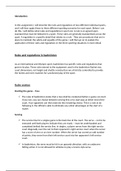Introduction
In this assignment, I will describe the rules and regulations of two different individual sports,
and I will then apply these to three different sporting scenarios for each sport. Before I can
do this, I will define what rules and regulations in sport are; A rule is an agreed upon
standard that must be followed in a sport. These rules are generally standardised across the
sport. A regulation is a specific detail that relates to a rule - They are procedures that are in
place to maintain the safety and equality of the game. I will then go on to explain the
application of these rules and regulations in the three sporting situations in more detail.
Rules and regulations in badminton
As an international and Olympic sport, badminton has specific rules and regulations that
govern its play. These rules extend to the equipment used in the badminton Racket size,
court dimensions, net height and shuttle construction are all strictly controlled to provide
the fairest and even matches for sanctioned play of the sport.
Rules section
Starting the game – Toss
The rules of badminton states that a toss shall be conducted before a game can start.
If you win, you can choose between serving first or to start play at either end of the
court. Your opponent can then exercise the remaining choice. This is a rule as by
following it, the official is able to eliminate any unfair advantages at the start of a
match
Serving
The service line for a singles game is the back line of the court. The serve -- not to be
executed until both players indicate they are ready -- must be underhanded and
completed behind the service line. In singles, a player serves from the right service
court diagonally over the net to their opponent’s right service court when the server
has a score of zero or an even number. When the server has scored an odd number
of points, they serve from their left service court into her opponent’s left service
court.
In badminton, the serve must be hit in an upwards direction, with an underarm
hitting action. It is not allowed for athletes to play a tennis style serve.
, The main rule regarding serving technique is that when you hit the shuttle, it must
be below the waist. To be exact, the rules define this to be a height level with the
lowest part of your ribcage. This is an important rule: it’s the one that prevents you
from playing a smash as your serve which if done would usually be considered a
fault.
If a player touches the net with any part of their body or racket then it is deemed a
fault and their opponent receives the point.
Court areas and service
Court - During a rally, a player can hit the shuttle from any position on his side of the
net. The singles sidelines indicate the left and right boundary. A rally ends when the
shuttle touches the playing surface in bounds or a fault is committed. In between
games and after the first player scores 11 points in the third game, change ends with
your opponent.
'Let' is called by the umpire, or by a player (if there is no umpire), to halt play. A 'let'
may be given for any unforeseen or accidental occurrence that could be distracting
to the players and something that the umpire has no control over. The rules of
badminton consider the following as 'lets’ and play would be halted as a result:
- If a shuttle is caught in the net and remains suspended on top or, after passing over
the net, is caught in the net, it shall be a 'let' except on service.
- If, during service, the receiver and server are both faulted at the same time, it shall
be a 'let'.
If the server serves before the receiver is ready, it shall be a 'let'.
- If, during play, the shuttle disintegrates and the base completely separates from the
rest of the shuttle, is shall be a 'let'.
- If a line judge is unsighted and the umpire is unable to make a decision, it shall be a
'let'.
- A 'let' may occur following a service court error. When a 'let' occurs, the play since
the last service shall not count and the player who served shall serve again, except
where in situations where the Law of Service Court Errors is applicable.





